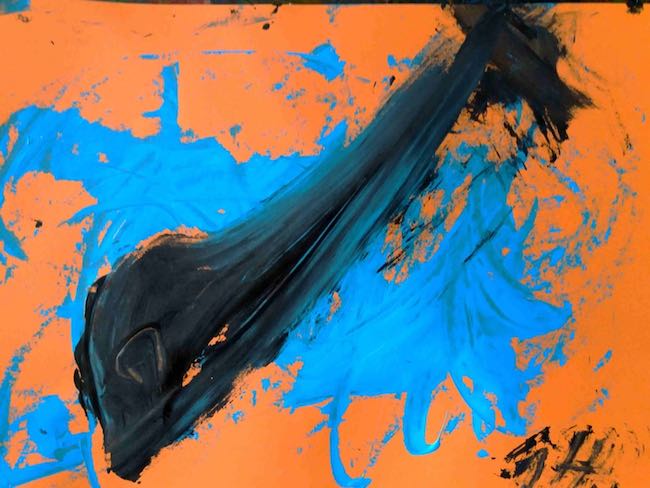Il dualismo che avvolge l’uomo contemporaneo, quello tra luce e ombra, tra desiderio di solarità e positività e attitudine a lasciarsi travolgere dal buio di alcuni accadimenti o pensieri, è terreno di studio e di analisi di molti artisti che ampliano la ricerca da se stessi e il loro personale sentire, al mondo che li circonda, alle persone che incrociano quotidianamente le loro esistenze e che costituiscono un termine di confronto così come di osservazione, suscitando emozioni e sensazioni che poi si mescolano alle proprie divenendo protagoniste di un’opera. La pittrice di cui parlerà oggi sceglie uno stile immediato e istintivo per raccontare il contrasto che appartiene non solo alla propria interiorità bensì anche al modo di vivere attuale.
Quando l’Espressionismo Astratto cominciò ad affermarsi, intorno agli anni Cinquanta del Ventesimo secolo, fu subito chiaro al pubblico e agli addetti ai lavori che si opposero al considerare arte le opere degli esponenti del movimento che la mancanza di regole stilistiche avrebbe generato una libertà espressiva forse troppo all’avanguardia per l’epoca, eppure la determinazione degli irascibili, come furono definiti da un articolo dell’Herald Tribune in cui il giornalista commentava la lettera di protesta pubblicata dal New York Times con cui i fondatori del gruppo protestarono la decisione del Metropolitan Museum di escluderli dalla grande esposizione sull’arte contemporanea americana, riuscì a far affermare il loro movimento prima negli Stati Uniti e poi in Europa. Il forte impatto delle loro opere, la libertà esecutiva e il messaggio immediato e primordiale che faceva vibrare le corde emotive dell’osservatore riuscirono a conquistare sia un pubblico più raffinato che quello meno colto ma ugualmente sensibile alla piacevolezza dell’arte. Proprio in virtù di un approccio tanto impulsivo da parte degli esponenti della corrente, era inconcepibile per i fondatori Jackson Pollock, Mark Rothko, Barnett Newmann, Willem de Koonig, Arshile Gorky, tanto diversi tra loro per stile espressivo, dare linee guida ben precise e limitanti fatta eccezione per quella di infondere emozione nelle loro tele, qualsiasi fosse la singola inclinazione creativa. Dunque l’impulsiva e impetuosa Action Painting di Pollock coesisteva con il meditativo e suggestivo Color Field di Mark Rothko, così some il minimalismo silenzioso di Barnett Newmann era affiancato dalla pittura segnica di Franz Kline, permettendo a ciascuno in questo modo di sentirsi completamente libero di assecondare quei moti interiori che in un artista non possono non trasferirsi sulla tela. In particolare la pittura segnica di Kline, tanto misteriosa ed evocativa, ebbe dei grandi interpreti anche in Europa, sebbene ciascuno con la propria personale cifra stilistica, tra cui Hans Hartung, artista tedesco naturalizzato francese le cui tele infondevano nell’osservatore la sensazione di trovarsi davanti a un impeto irresistibile che doveva essere comunicato, ed Emilio Vedova, uno dei maggiori esponenti dell’Arte Informale italiana, che riempiva le opere delle sue palpitanti emozioni attraverso un gesto istintivo, avvalendosi del forte impatto del nero sulla tela bianca, quasi concitato per l’urgenza di lasciar fuoriuscire tutto ciò che doveva necessariamente essere narrato. L’artista austriaca Nicki Heis, formatasi da autodidatta, prende spunto dai grandi maestri della pittura segnica per elaborare uno stile particolare, pieno di una gamma cromatica spesso vivace, ispirata dall’amore per il mare e per la fauna che lo abita, mostrando tutta la fascinazione che esercitano su di lei i pesci ma anche i coralli, l’universo variopinto che affolla i fondali marini.
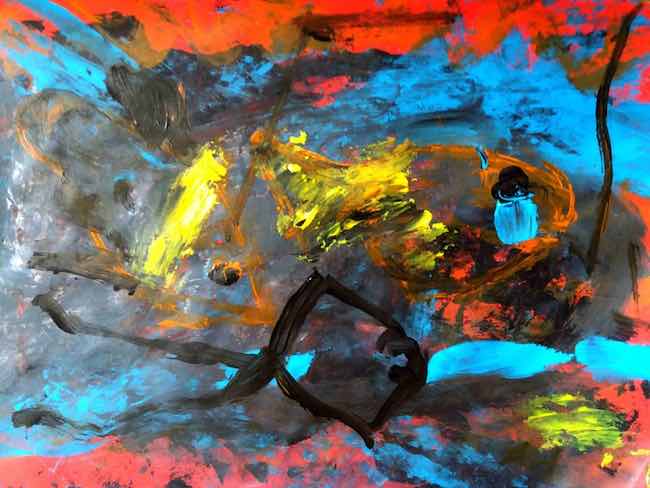
Il suo approccio pittorico è istintivo ma anche semplice dal punto di vista del messaggio che ne fuoriesce, lo sguardo sembra perdersi nella sua gamma cromatica, nei segni che ingannano lo sguardo poiché sembrano condurre verso una forma conosciuta, a dispetto dell’indefinitezza che contraddistingue il suo approccio alla tela.
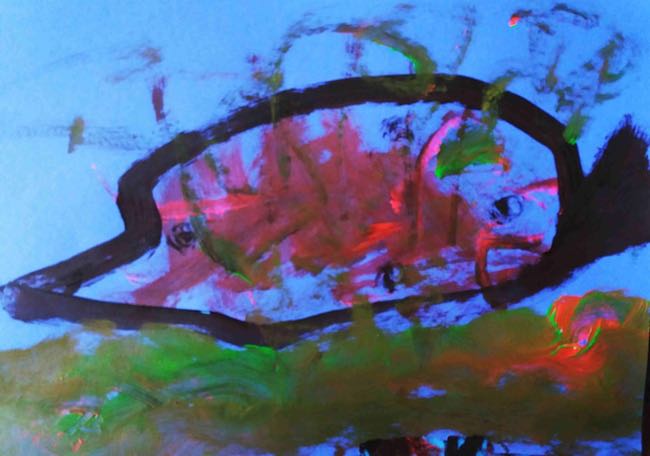
Tuttavia, accanto al mondo multiforme e vivace delle opere in cui domina il colore, ve n’è un altro che sembra invece tendere verso le ombre, verso una maggiore introspezione o forse verso uno sguardo meno positivo, meno sorridente perché in fondo l’esistenza è costituita dall’alternanza tra luce e ombra, tra circostanze piacevoli e meno piacevoli e che possono modificare lo sguardo verso il quadro generale, oscurando tutto ciò che fino a poco prima sembrava essere pieno di luminosità.
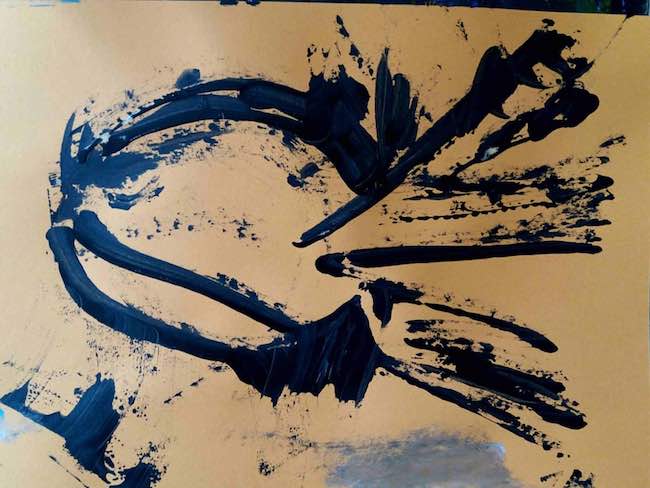
La narrazione di Nicki Heis, il suo suggerimento all’osservatore, è quello di non escludere i momenti più bui bensì di interpretarli come fasi di passaggio, come accadimenti che condurranno in un secondo momento di nuovo a guardare le cose attraverso i caleidoscopici colori perché in fondo i frangenti più negativi, l’oscurità, sebbene appaiano intensi e soffocanti, non permangono mai tanto a lungo. Il mondo dei pesci dunque diviene allegoria dell’essere umano contemporaneo, ne interpreta il caleidoscopio di emozioni e di sensazioni in cui spesso si trova immerso così come la sua irrequietezza e a volte la tendenza a galleggiare in superficie dimenticando l’importanza di andare più a fondo, di non fermarsi all’entusiasmo e all’estetica del colore bensì assumendo un atteggiamento più introspettivo che gli permetta di osservare differenti sfaccettature della realtà.

Nella fase riflessiva infatti, quando la gamma cromatica si riduce notevolmente, il segno diventa spesso più indefinito, più diretto forse ma anche più vero perché spogliato di tutte le distrazioni costituite da un prisma cromatico che tende ad allontanare dall’essenza, che sembra essere elemento di disturbo in una fase nella quale ciò verso cui l’interiorità ha bisogno di avvicinarsi è quella sostanza che spesso si perde nella confusione di voci, luci, colori e che devia l’attenzione sull’effimero.
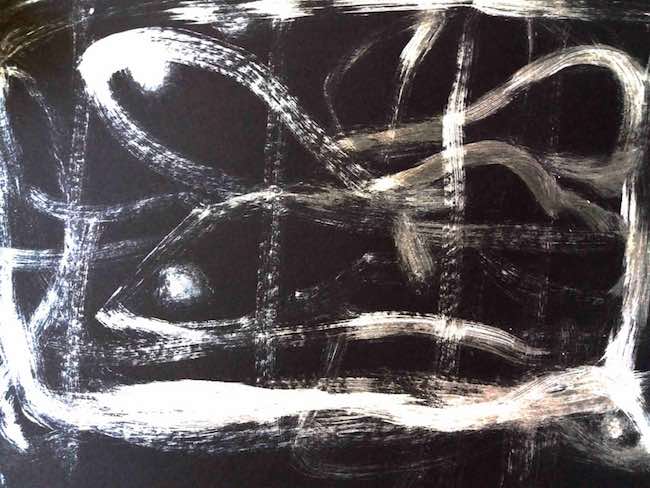
Tuttavia il punto di vista di Nicki Heis è anche orientato a considerare la natura, rappresentata dai pesci, come un universo delicato e sensibile, spesso calpestata dall’uomo inconsapevole di danneggiare l’ambiente che lo circonda giungendo persino a compromettere la sua stessa sopravvivenza; ecco perché dà il titolo solo alla serie di opere che appartengono al progetto, o forse sarebbe meglio dire il processo di presa di coscienza attraverso il quale l’essere umano dovrebbe uscire dalla sua posizione centrica nel mondo e osservare con maggiore attenzione, rispettare e ascoltare le voci silenziose degli animali.
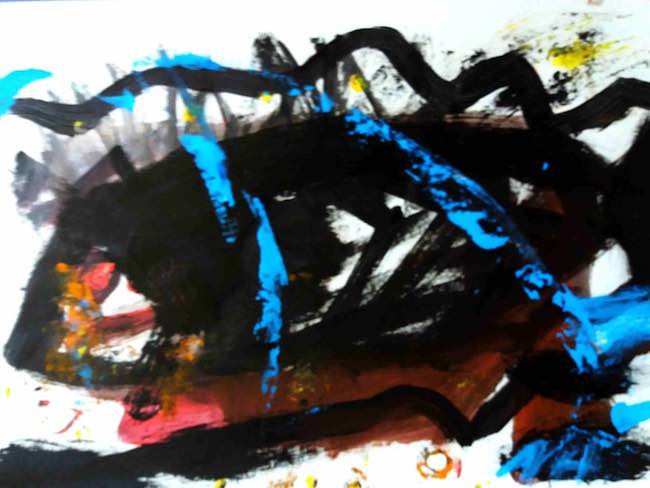
Meine Fische weinen (I miei pesci piangono) è il titolo della serie pittorica e anche laddove la figurazione scompare e volge verso l’astratto totale è percepibile il disagio di una sussistenza complessa, in contrasto con tutto ciò che ruota intorno perché troppo ostile da poter essere rassicurante; si nasconde in questo tipo di visione un’attenta analisi della società contemporanea, di quel sentirsi soli nella moltitudine e di non essere in grado di essere di sostegno al prossimo, al contrario a volte è proprio da chi viene creduto più vicino che si ricevono i colpi più duri. Dunque da un lato la metafora dell’essere umano al continuo inseguimento di una parte effimera di sé, un lasciarsi trasportare dalle mille luci e dagli infiniti colori di tutto ciò che è esterno, di quella girandola di opportunità, di opzioni, di illusioni costituite dalla società attuale a causa delle quali dimentica di osservare anche un’interiorità che tuttavia non può evitare di fuoriuscire, dall’altro un approccio più animalista, laddove il mondo marino costituisce in qualche modo una via di fuga, un rifugio per una fauna troppo spesso maltrattata e non considerata, timorosa che l’uomo possa continuare a distruggerla.
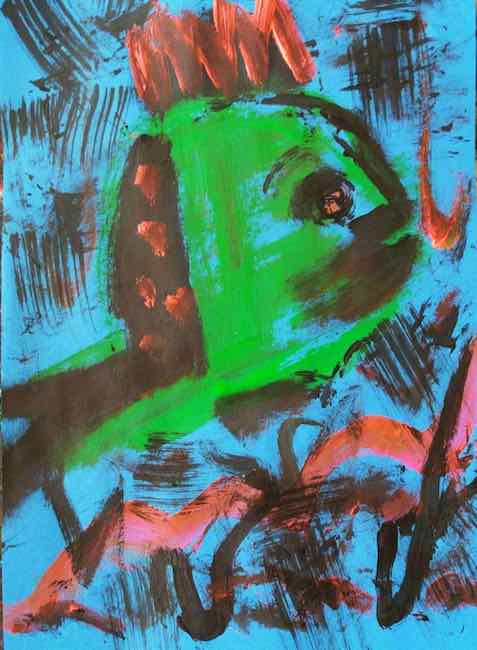
La gamma cromatica vivace rappresenta il desiderio di quel mondo sommerso di mettersi in mostra, di attirare l’attenzione sulla sua bellezza, sulle sue molteplici sfaccettature nell’auspicio che l’uomo ne prenda coscienza, comprenda l’importanza del ruolo di quella che non è semplice bellezza bensì una parte vitale di un universo appartenente all’equilibrio dell’ecosistema, e che come tale deve essere rispettato. Nicki Heis vive e lavora a Vienna, ha all’attivo diverse mostre collettive nella sua città e il 29 agosto esporrà nella mostra di inaugurazione della nuova galleria Publicartists di Vienna.
NICKI HEIS-CONTATTI
Email: info@publicartists.online
Facebook: https://www.facebook.com/nicki.heis.5
The sign painting of Nicki Heis, narrating a world divided between colours and shadows
The dualism that envelops contemporary man, that between light and shadow, between the desire for sunshine and positivity and the tendency to let oneself be overwhelmed by the darkness of certain events or thoughts, is the terrain of study and analysis of many artists who extend their research from themselves and their personal feelings to the world around them, to the people who cross their lives on a daily basis and who constitute a term of comparison as well as of observation, arousing emotions and sensations that then mingle with their own and become the protagonists of an artwork. The painter we are going to talk about today chooses an immediate and instinctive style to narrate the contrast that belongs not only to her own interiority but also to the current way of life.
When Abstract Expressionism began to assert itself, around the 1950s, it was immediately clear to the public and insiders who opposed considering the artworks of the movement’s exponents as art that the lack of stylistic rules would generate a freedom of expression that was perhaps too avant-garde for the time, yet the irascible, as they were defined by an article in the Herald Tribune in which the journalist commented on the letter of protest published by the New York Times where the founders of the group protested the Metropolitan Museum’s decision to exclude them from the great exhibition on contemporary American art, succeeded in making their movement assert itself first in the United States and then in Europe. The strong impact of their artworks, the freedom of execution and the immediate and primordial message that made the observer’s emotional chords vibrate, succeeded in conquering both a more refined public and a less cultured one that was equally sensitive to the pleasantness of art. Precisely by virtue of such an impulsive approach on the part of the exponents of the current, it was inconceivable for the founders Jackson Pollock, Mark Rothko, Barnett Newmann, Willem de Koonig and Arshile Gorky, so different from each other in terms of expressive style, to give precise and limiting guidelines except that of infusing emotion into their canvases, whatever their individual creative inclination. Thus, Pollock’s impulsive and impetuous Action Painting coexisted with Mark Rothko’s meditative and evocative Colour Field, as well as Barnett Newmann’s silent minimalism was flanked by Franz Kline’s sign painting, thus allowing each to feel completely free to indulge those inner impulses that in an artist cannot but transfer onto canvas.
In particular, Kline’s sign painting, so mysterious and evocative, also had great interpreters in Europe, albeit each with their own personal stylistic signature, including Hans Hartung, a German artist naturalised French, whose canvases instilled in the observer the feeling of being in front of an irresistible impetus that had to be communicated, and Emilio Vedova, one of the major exponents of Italian Informal Art, who filled his paintings with his palpitating emotions through an instinctive gesture, making use of the strong impact of black on the white canvas, almost agitated by the urgency of letting out everything that had to be narrated. Self-taught Austrian artist Nicki Heis takes her cue from the great masters of sign painting to elaborate a particular style, full of an often lively chromatic range, inspired by her love for the sea and the fauna that inhabits it, showing all the fascination that the fish, but also the corals, the multi-coloured universe that crowds the seabed exerts on her.
Her pictorial approach is instinctive but also simple from the point of view of the message that emerges, the gaze seems to get lost in her range of colours, in the signs that deceive the eye as they seem to lead towards a known form, in spite of the indefiniteness that characterises her approach to the canvas. However, alongside the multiform and lively world of the artworks in which colour dominates, there is another that seems to tend towards the shadows, towards greater introspection or perhaps towards a less positive, less smiling gaze because, after all, existence is made up of alternating light and shade, between pleasant and less pleasant circumstances that can change the gaze towards the big picture, obscuring everything that until a short time before seemed to be full of brightness. Nicki Heis’s narration, her suggestion to the observer, is not to exclude the darkest moments but to interpret them as passing phases, as events that will later lead one to look at things through kaleidoscopic colours again, because after all, the most negative, the darkest, although they appear intense and suffocating, never remain so long. The world of fish thus becomes an allegory of the contemporary human being, interpreting the kaleidoscope of emotions and sensations in which he often finds himself immersed, as well as his restlessness and sometimes tendency to float on the surface, forgetting the importance of going deeper, of not stopping at the enthusiasm and aesthetics of colour but taking a more introspective attitude that allows him to observe different facets of reality. In the reflective phase in fact, when the chromatic range is considerably reduced, the sign often becomes more indefinite, more direct perhaps, but also more real because it is stripped of all the distractions constituted by a chromatic prism that tends to distance itself from the essence, which seems to be an element of disturb in a phase in which what interiority needs to approach is that substance that often gets lost in the confusion of voices, lights, colours and that diverts attention to the ephemeral.
However, Nicki Heis’s point of view is also oriented towards considering nature, represented by fish, as a delicate and sensitive universe, often trampled upon by man unaware that he is damaging the environment that surrounds him, even going so far as to jeopardise his own survival; this is why she only gives the title to the series of paintings that belong to the project, or perhaps it would be better to say the process of becoming aware through which human beings should come out of their centred position in the world and observe, respect and listen to the silent voices of animals with greater attention. Meine Fische weinen (My fishes cry) is the title of the pictorial series, and even where the figuration disappears and turns towards total abstraction, the unease of a complex subsistence is perceptible, in contrast to everything that revolves around it because it is too hostile to be reassuring. This type of vision hides a careful analysis of contemporary society, of feeling alone in the multitude and not being able to support others, on the contrary, sometimes it is precisely from those believed to be closest that the hardest blows are received. Thus, on the one hand, the metaphor of the human being in continuous pursuit of an ephemeral part of himself, a letting himself be carried away by the thousand lights and infinite colours of all that is external, of that whirlwind of opportunities, of options, of illusions constituted by today’s society due to which it forgets to observe even an interiority that nevertheless cannot avoid escaping; on the other hand, a more animalistic approach, where the marine world somehow constitutes an escape route, a refuge for a fauna that is too often mistreated and disregarded, fearful that man may continue to destroy it. The lively colour palette represents the desire of that underwater world to show itself off, to draw attention to its beauty, to its many facets in the hope that man will become aware of it, understand the importance of the role of what is not mere beauty but a vital part of a universe belonging to the balance of the ecosystem, and which as such must be respected. Nicki Heis lives and works in Vienna, has several group exhibitions in her city to her credit, and will be exhibiting in the opening show of the new Publicartists gallery in Vienna on 29 August.


